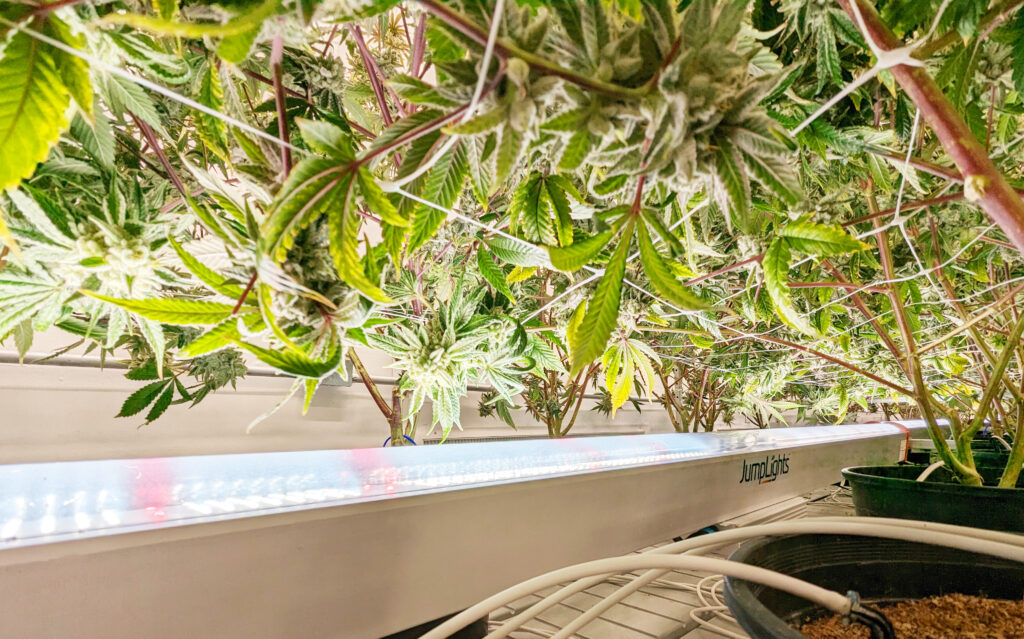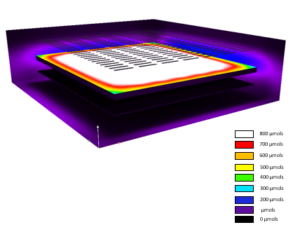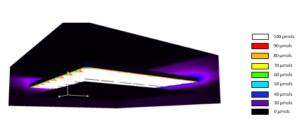
January 3, 2024
In the dynamic world of controlled environment agriculture, one innovative technique is capturing attention for its potential to transform the cultivation landscape—intra-canopy lighting. Recent studies have shown an increase in yield and/or improved fruit quality in all-year round greenhouse crops such as tomato, cucumber and sweet pepper [1,2]. Recently, its application in cannabis cultivation has drawn interest, promising to optimize growth and yield. In this article, we explore the science behind intra-canopy and under canopy lighting, shedding “light” on its relevance, potential benefits, and considerations in the context of cannabis cultivation.
What are the Different Types of Intra-Canopy Lighting?
It’s important to define the different types of intra-canopy lighting and understand the attributes of each. Equally important is understanding the manufacturer and quality of the intra-canopy lighting [3].

- Inter-Canopy Lighting: Inter-canopy lighting refers to fixtures placed inside the canopy rather than being mounted on the side or bottom. Sometimes, these fixtures are hung by wires from above or suspended high into the plant canopy by posts. The fixtures are typically very close to the plants, which can lead to issues such as photobleaching and microclimates of uneven temperature. Additionally, they may interfere with airflow.
- Side-Canopy Lighting: Side-canopy intra-canopy lighting involves fixtures often being mounted directly to the trellises. However, this type still has the drawback of not effectively illuminating the center of the canopy. Moreover, it can be a significant nuisance as it may obstruct growers’ access to plants for regular care and inspection. If branches move towards the edges of the trellis, they can come too close to the fixtures, resulting in photobleaching.
- Under Canopy Lighting: Under canopy lighting is the least cumbersome setup and least likely to cause bleaching. Fixtures are mounted at the bottom and point upward towards the center of the canopy, providing better uniformity and improved light distribution, especially for cannabis. During harvest, these lights are not in the way, allowing for increased operational efficiency, and they do not interfere with airflow [4].
Why Use Intra-Canopy Lighting for Cannabis?
- Light Insufficiency Within the Canopy: Cannabis plants, like many other crops, face challenges related to uneven light distribution within canopies. Intra-canopy lighting strategically targets lower leaves, addressing light insufficiency and promoting more uniform light distribution within the cannabis canopy. This targeted approach aims to enhance photosynthesis and boost overall plant productivity.
- Improving Total Light Absorption: Research indicates that intra-canopy lighting can lead to increased total light absorption, a critical factor for cannabis growth [5]. By providing supplemental light to shaded lower leaves, intra-canopy lighting contributes to improved photosynthetic activity and has the potential to positively impact biomass production and yield.
What Factors Should be Considered for Intra-Canopy Lighting of Cannabis?
- Spectrum: While studies on cannabis and intra-canopy lighting are still evolving, discussions revolve around the specific light spectrum and adequate PPFD levels required for optimal cannabis cultivation. Recently, we published an article on the effects of far-red in cannabis. Far-red light has shown promise in improving biomass and maximizing yield for cannabis cultivation.
- Light Intensity (PPFD): Considerations for the unique lighting requirements of cannabis plants are crucial. Careful management of light intensity and spectrum is essential to avoid potential issues such as leaf damage or excessive light exposure. For this reason, JumpLights designed their intra-canopy lighting to use the under-canopy strategy. This allows ideal and uniform light intensity throughout the canopy, without concern for photobleaching. By mounting at the bottom, the fixtures are out of the way, allowing easy access to plants for care and harvesting, and they do not block airflow.
- Energy Consumption: A simple method of applying intra-canopy lighting, similar to the under-canopy solutions that JumpLights offer, involves supplanting some of the power from the top-lighting and instead moving it to the under-canopy. For example, growers can take a 1000W HPS and split the wattage into a more balanced approach, providing increased photons, in the intensity and spectrum plants need, for the same power consumption. For instance, 1000W can be split into the Budkicker fixture running at a range of 680-850W and the solidly installed under-canopy Catalyst fixture running at 260W-340W. The result of this switch changes the total PPFD inside the canopy to X and Y, as seen in the photometric mapping below.

Over-Canopy Photo-metrics

Under-Canopy Photo-metrics
Fixtures Built to Perform
There is still much to learn about intra-canopy lighting, and JumpLights is up for the challenge [4]. Already, JumpLights has been selected for a large, multistate commercial operation trial and has performed better than expected. The quality, quantity, and weight of flower production outperformed when using the Catalyst under-canopy fixtures compared to using just HPS or LED fixtures for toplights.
Conclusion
The improvements observed in other crops using intra-canopy lighting underscore the relevance of exploring and optimizing intra-canopy lighting techniques for cannabis cultivation. While cannabis-specific studies on intra-canopy lighting are still emerging, the potential benefits are positive. JumpLights is part of the ongoing exploration in this field with the revolutionary Catalyst fixture—a device that locks into cannabis benching setups within the understory. The Catalyst boasts light intensity and spectrum engineered specifically for cannabis, and a form-factor tailored to work in a cannabis production environment. As advancements in horticultural lighting technology continue, the journey into understanding the implications and advantages of intra-canopy lighting for cannabis growth and yield promises to be an exciting and evolving frontier.
References:
[1] Source: ScienceDirect
[2] Source: Frontiers
[3] Source: Produce Grower
[4] Source: Greenhouse Grower
[5] Source: Shine Lighting




